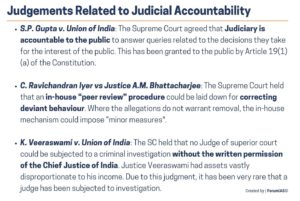Contents
- 1 Introduction
- 2 What are the salient observations in the Report?
- 3 What is the meaning of Judicial Accountability?
- 4 What is the current framework of Judicial Accountability in India?
- 5 What is the need to enhance Judicial Accountability?
- 6 What are the challenges in enhancing Judicial Accountability?
- 7 What steps can be taken to enhance Judicial Accountability?
- 8 Conclusion
| For 7PM Editorial Archives click HERE → |
Introduction
The High Court of Odisha has published a one-of-a-kind annual report of its performance in 2021. By the standards of the Indian judiciary, this is a rare exhibition of transparency. The report outlines the performance of the High Court and the lower judiciary in the State. The Chapter ‘Introspection and Challenges’ in the Report observes, “For any institution, introspection is necessary to overcome the drawbacks and to enhance efficiency.” With this report, the High Court has brought some transparency in its functioning and has subjected itself to the scrutiny of the common citizen. This has brought the issue of judicial accountability into the limelight and might induce other courts to follow higher standards of transparency and accountability.
What are the salient observations in the Report?
The Report provides detailed view of breakup of cases (cases pending at the start of the year, new cases, disposed cases, cases pending at the end of the year) for each District Court. It also provides the break-up of sanctioned strength and available Judges for each Court.
It contains a section explaining the reasons for delays and backlog at the district level . The tendency of higher courts to “stay” proceedings, the uneven distribution of cases amongst judges in trial courts and the non-availability of witnesses due to transfers are among the major reasons cited by it for delays. It also sheds light on the administrative functioning of the Court.
The Report also lists the initiatives undertaken by the Court, e.g., the initiatives to address the digital divide in the judiciary. Order Communication Portal (OCP) enables digital sending of High Court orders to subordinate courts thus reducing time for subsequent action.
What is the meaning of Judicial Accountability?
The term Accountability means being responsible for decisions or actions. Generally, it means being responsible to any external body. Transparency in the functioning and decision-making process is one of the crucial aspect that ensures accountability.
The term judicial accountability thus means that the judges are responsible for the decisions they deliver. It also means that Judges be held accountable for their conduct.
The Judiciary is not subjected to the same level of accountability as the Executive or the Legislative wings of the Government. The reason is that the principles of Judicial Independence and Accountability are sometimes regarded as fundamentally opposed to one another. Judicial independence is considered ‘an essential pillar of liberty and the rule of law’. So if Judiciary is made accountable to the Legislature or the Executive it will impact its Independence. So special provisions have been provided to ensure judicial accountability.
What is the current framework of Judicial Accountability in India?
The Constitution of India provides for the removal of the judges of the Supreme Court of India and the High Courts for misbehaviour and incapacity by means of impeachment. The provisions of impeachment have been provided in the Article 124(4) (SC Judge) and Article 217(1)(b) (HC Judge) of the Constitution. To date, only one impeachment proceeding was initiated against a Supreme Court judge but the procedure failed. Similarly, no High Court Judge has been impeached so far.
Judges (Inquiry) Act, 1968 was passed to regulate the investigation procedure and to find proof showing incapacity and misbehavior on the part of the judges of the Supreme Court and the High Courts.
Article 235 of the Constitution provides for the ‘control’ of the High Court over the subordinate judiciary. It provides an effective mechanism to enforce accountability of the lower judiciary.
The Supreme Court of India adopted a Charter called the Restatement of Values of Judicial Life in 1997. It is the restatement of the pre-existing and universally accepted norms, guidelines and conventions observed by Judges. All the High Courts of the country have also adopted the same. The Charter contains guidelines for general behaviour of the Judges. However, it is not an instrument of judicial accountability in strictest terms.
A resolution of the Supreme Court in December 1999 declared that an ‘in-house procedure’ would be adopted to take action against judges who act against accepted values of judicial life. In case of a complaint against a judge, the procedure allows the Chief Justice of that Court to set up an inquiry with a 3-judge committee. If the allegations are serious, the committee may recommend initiating proceedings for removal.
What is the need to enhance Judicial Accountability?
First, it will induce the judges to improve efficiency and deliver quality judgements thereby ensuring justice in the society. There have been several ‘shocking‘ judgments in recent times e.g., a Bombay High Court Judge ruled that groping a child without ‘skin-to-skin contact with sexual intent’ does not amount to the offence under the POCSO Act.
Second, It will help in ensuring an impartial functioning that would augment public trust in the institution of judiciary. For instance, a major controversy erupted when a sitting Chief Justice of India was accused of sexual harassment. The CJI, instead of ordering external enquiry, set up an internal Committee to look into the matter. The CJI himself appointed the Judges, raising concerns of conflict of interest. The Committee absolved him, while the complainant was not allowed to be represented by a lawyer.
Third, the scope of information which the courts are willing to share under RTI is not too wide. For instance, the Bombay High Court recently ruled that its ‘file notings’ on administrative matters are not required to be disclosed under the RTI Act. The reluctance of Judiciary to subject itself to greater transparency became evident when a former CJI remarked that the “institution of Judiciary can’t be destroyed in the name of transparency“.
Fourth, Unlike the executive, the judiciary is not under any legal obligation to prepare annual reports or table them before Parliament or the State Legislature. Only the High Courts of Madras, Himachal Pradesh and Tripura had published an annual report in the last two years.
Fifth, there exists no provision in the Indian Constitution which directs in reviewing the Supreme Court’s decision. Except for the Supreme Court itself, there exists no other body or council to have a check on the decisions passed by the Apex Court.
Sixth, in the absence of any accountability, the pendency of cases has reached unprecedented levels (> 4 Crore cases in lower courts). Since, Judges are not accountable to the people or to any other organs of the State, no concrete action has been undertaken to address this pendency. Judicial Accountability might have provided an element of external pressure on the Judiciary to reduce pendency.
Seventh, the process of appointment of judges to higher judiciary lacks transparency. There is no visibility about what importance is given to credentials of judges in their ideological adherence to the constitutional ideals of a secular, socialist democratic republic etc.
Eighth, there are several shortcomings in the in-house procedure. There is no statutory basis for the procedure. No judge (who faced such committee) has agreed to resign because there was an adverse report by the committee. In some cases, allegations requiring further investigation were dismissed by such committees.
Ninth, a prominent news portal reported that in 2019, only 7 Judges of the Supreme Court voluntarily declared their assets. So self-regulation appears to have some limitations.
What are the challenges in enhancing Judicial Accountability?
The most important challenge for the regulation of judicial accountability is that the judiciary is an independent organ and the independence of the judges cannot be done away with. Any attempt to make the Judiciary accountable to the Legislature or Executive will make it susceptible to external pressure. It is very difficult to balance the Judicial Accountability vis-a-vis Judicial Independence.
There exists no other way in which a judge can be removed except through impeachment and the process is long and complex. Due to this, it is difficult to augment judicial accountability. Again, the process can’t be diluted as it will impinge on judicial independence.
Moreover, the SC and HC have the power of contempt that prevent imposition of anything on the judiciary without their consent. The judiciary is the final interpreter of laws, policies, rules etc. and can easily strike down anything as per its will.
What steps can be taken to enhance Judicial Accountability?
First, Parliament can enact a law that mandates Judiciary to publish an annual report. This law should clearly outline the expected content of the report and establish a clear timeline for its publication.
Second, In India, the Judicial Standards and Accountability Bill was floated in 2010, but eventually lapsed. A new Bill on setting judicial standards is necessary. As suggested by a former Chairperson of the Law Commission, the new Bill must address the concerns with the old Bill and should avoid giving excessive control to the Legislature or the Executive.
A permanent disciplinary committee should be set up at the central level to deal with complaints against judges. This committee should recommend further course of action based on the seriousness of misconduct (e.g., setting up a judicial inquiry committee under the Judges Inquiry Act for major misconduct).
Third, the SC should clarify the extent and scope of RTI applicability to the judiciary. This will help in avoiding divergence in RTI response across the states.
Fourth, the judiciary can also be brought under the scope of Lokpal to enhance accountability as seen in countries like Sweden where judiciary comes under the scope of the ombudsman.
Fifth, a regular performance evaluation system for judges should be established. There is a mechanism of evaluation at lower judicial level. There is no performance evaluation for higher judiciary. It is difficult to create such a system. Best practices from global experience can be suitable adapted as a first step.
Conclusion
The actual challenge is to grant as much judicial independence as is necessary to have cases adjudicated impartially and neutrally. Maintaining this equilibrium between accountability and independence is the real task at hand. The Odisha High Court’s step is the first step in this regard, however much more needs to be done.
Source: Indian Express, Indian Express, Indian Institute of Legal Studies
Discover more from Free UPSC IAS Preparation Syllabus and Materials For Aspirants
Subscribe to get the latest posts sent to your email.










